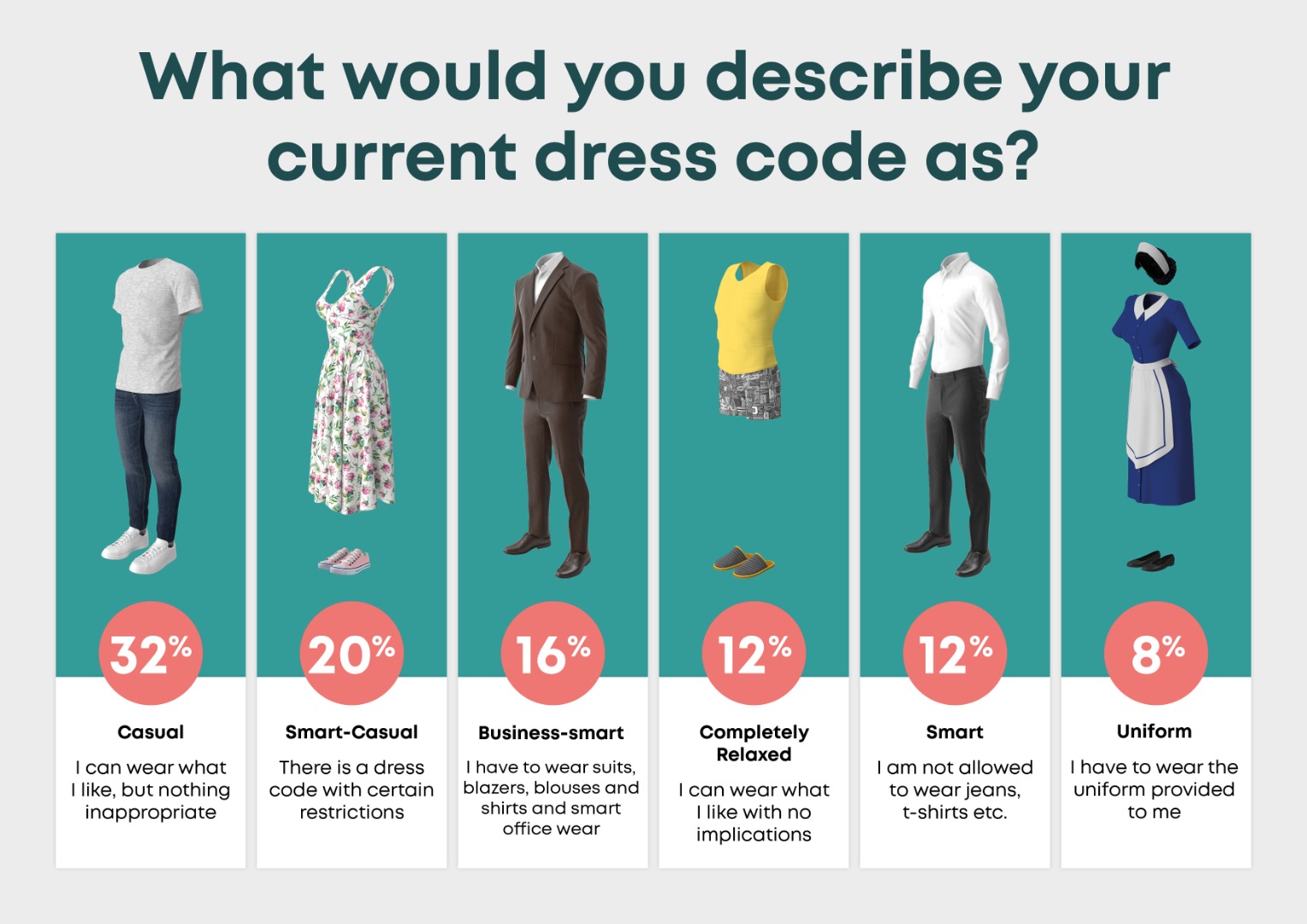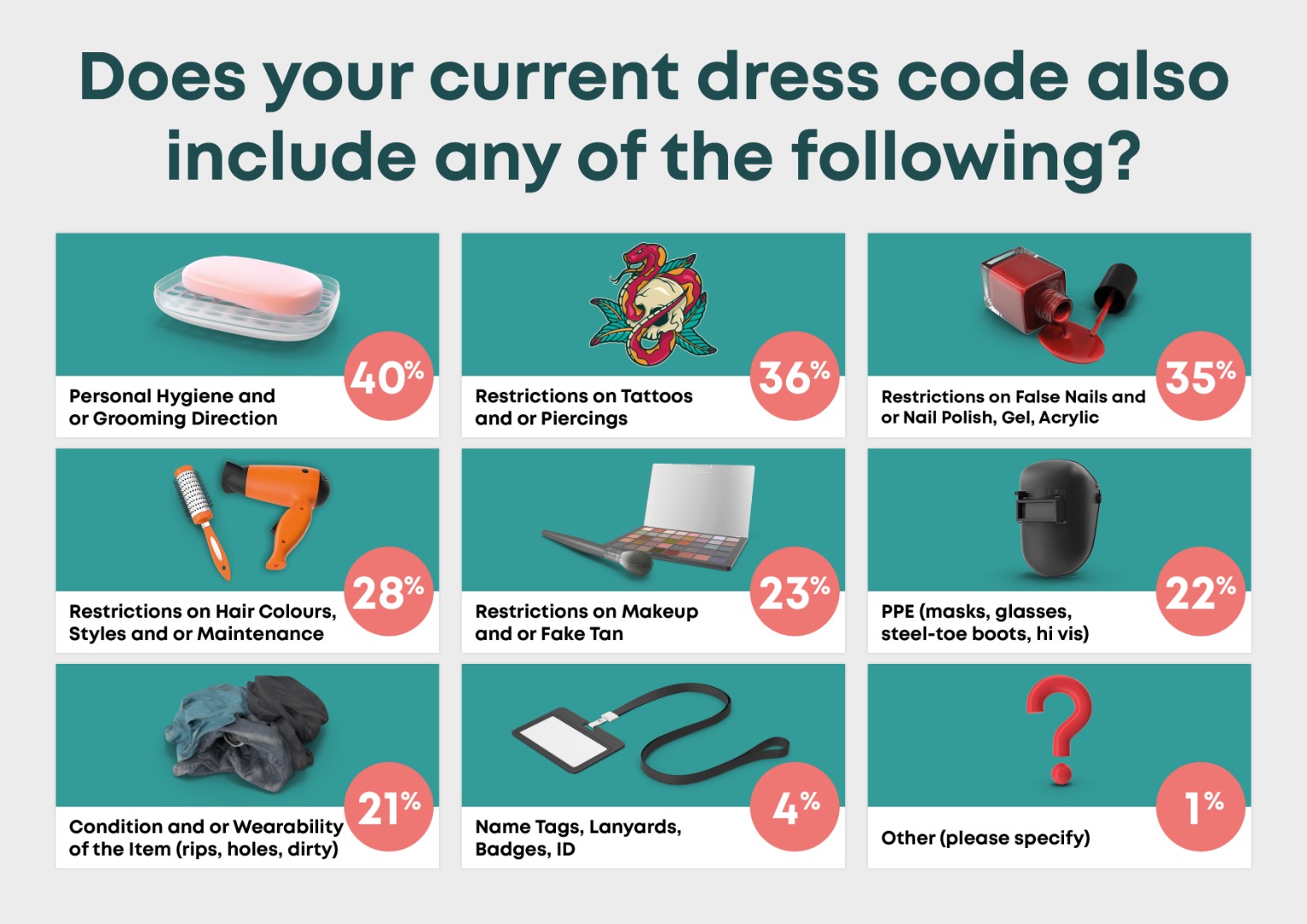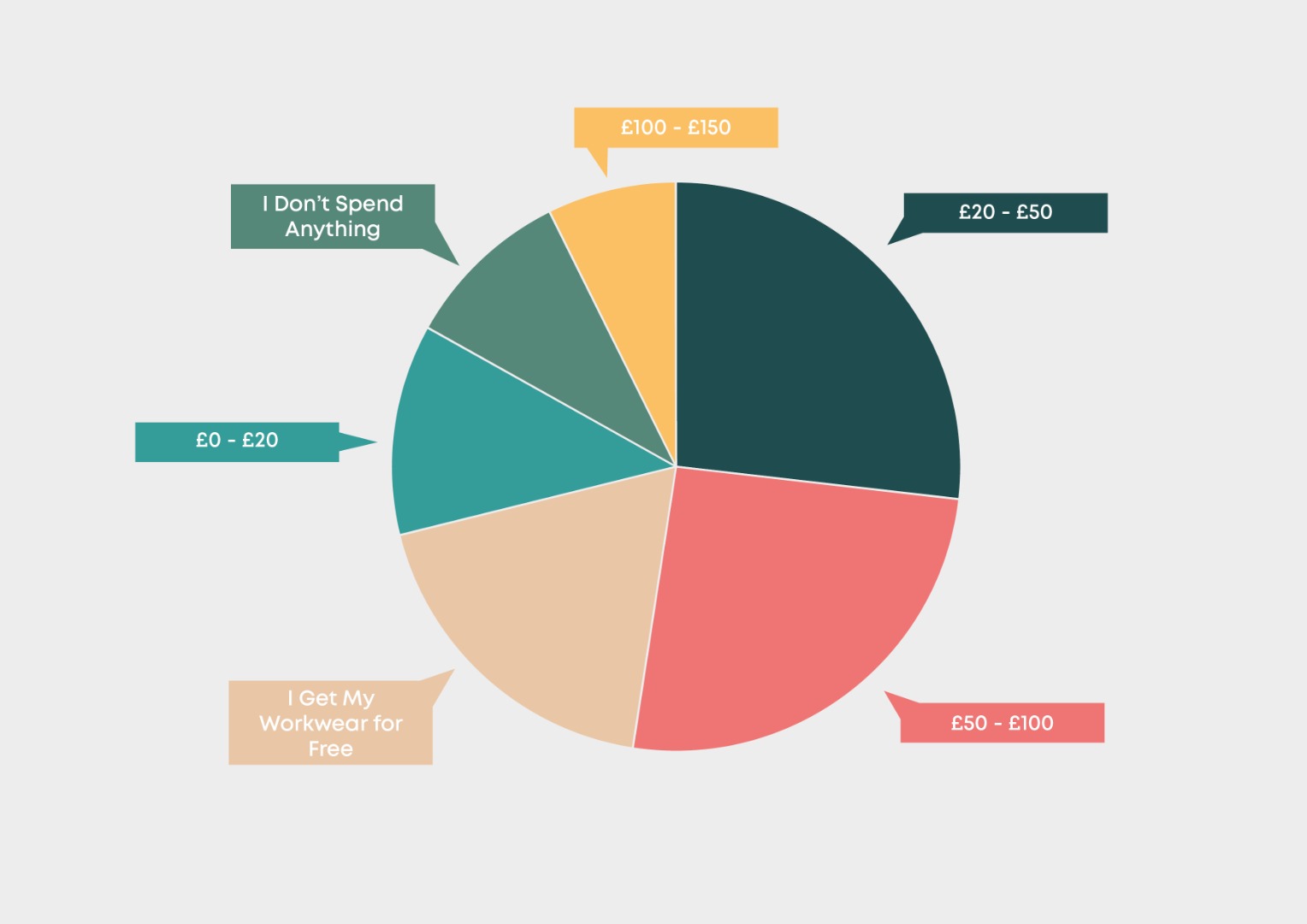The UK is hotting up and the workplace is getting warmer. Cue the great debate about when it’s acceptable to wear shorts, if strappy tops and sandals are professional or if the tie should be worn or not. Dress codes are put in place to help teams support the image that companies want to convey, but just how far do employees think employers are allowed to take their dress code?
From Crocs to the cost of living, we quizzed over 1,000 UK office workers to delve deeper into their dress code policies, their opinions and how much they spend each year on their work wardrobe.
Are Dress Codes Still Enforced in the UK?
We asked our respondents if their employer has a dress code. Unsurprisingly 74% said yes, their employer does have a dress code, 21% said no and only 5% wear a uniform. But that doesn’t mean that our respondents agree or follow the rules set out.
Dress for the Job you have
We took a deeper dive into our respondent's answers to discover which industries do and don't have dress codes and which ones require a uniform.
As an important public figure who wants to showcase their business and or responsibility, those most likely to have a dress code were:
• Real Estate and Housing - 100%
• Non-profit and Charity - 89%
• Business and Information - 83%
• Finance and Insurance - 75%
• Education - 71%
Working from home or working in a ‘hands-on approach’ industry shows that dress codes simply do not apply, those most likely to have no dress code were:
• Agriculture - 63%
• Creative, Arts & Design - 29%
• Nature Resources/Environment - 19%
• Marketing, Advertising & PR - 12%
• Construction, Utilities & Contracting -11%
Unsurprisingly, industries that are known for interacting with the general public seemed to take the top spot when it came to uniforms. Industries that racked up the most votes for uniforms were:
• Sales - 25%
• Leisure - 9%
• Motor Vehicle - 8%
• Manufacturing - 5%
• Health Services - 3%
Do Employees Agree With Dress Codes?
It seems that employees know where they stand with their employer in terms of whether they do or do not have a dress code, but it doesn’t mean that they all agree. We asked respondents if they feel that employers should be allowed to set and enforce a dress code.
A whopping 80% believe that employers should be allowed to set and enforce a dress code in the workplace and only 18% believe otherwise.
For the 1% who commented ‘other’ the findings presented that employers should only be allowed to set and enforce a dress code for the following reasons:
‘Yes if it’s for safety/PPE’
‘Depends on the work environment and
‘Depends on the industry and if the role is customer-facing. If not customer-facing, employees should be able to choose how they dress’
What Do the Generations Think of Mandatory Dress Codes?
Further research found that 60% of those who said ‘no’ were under the age of 35, compared to just 10% of those aged 45+ and only 5% of 18-24-year-olds responded ‘yes’.
It seems the older generation prefers dress codes to stay as they are whereas millennials and Gen X are looking for a more relaxed environment. Maybe because they spent a large proportion of their careers working from home with a smart shirt on camera and pj bottoms out of view.
Dress to Impress
We asked respondents to share what they would describe their current dress code as.
• Casual - I Can Wear What I Like, but Nothing Inappropriate - 32%
• Smart-casual - There Is a Dress Code With Certain Restrictions - 20%
• Business-smart - I Have To Wear Suits, Blazers, Blouses and Shirts and Smart Office Wear - 16%
• Completely Relaxed - I Can Wear What I Like With No Implications - 12%
• Smart - I Am Not Allowed To Wear Jeans, T-shirts Etc - 12%
• I Wear a Uniform - 8%
It seems that casual takes the top spot, closely followed by smart casual. It looks like the common workplace is leaning more on the relaxed side these days, possibly swayed by those working from home and the hot weather making its way to the UK.
For those that responded with completely relaxed - I can wear what I like with no implications, 69% were under the age of 35.
Unsurprisingly, completely relaxed and smart hold a joint place at the bottom of the list. It seems that employers won’t accept a ‘wear whatever you like’ attitude but they understand that smart attire may not be necessary every day, especially for those who may not be in client-facing roles.
For those that selected smart - I am not allowed to wear jeans, t-shirts etc over 41% of these respondents were aged 35 and over.
Business-smart takes third place with many industries from finance to education requiring employees to dress suitably for their jobs. Although times have changed, it looks to be that some industries must remain smart in their attire. Uniform remains comfortably at the bottom, saved for specific industries as we saw earlier such as healthcare and manufacturing.

What Are You Wearing to Work?
We asked our survey respondents to share what things they are not allowed to wear in conformance with their dress code.
• Short Skirts, Dresses, Playsuits and or Shorts - 30%
• Vests and or Crop Tops - 29%
• Revealing, Sheer and or Low Cut Tops - 29%
• Ripped Jeans - 27%
• Band T-Shirts and or Large Graphics - 24%
• Leggings - 23%
• Joggers - 23%
• Shorts - 23%
• Open-Toed Footwear, Sandals and or Flip Flops - 22%
• Caps and or Hats - 19%
• Sportswear (leggings, football tops, cycling shorts) - 18%
• Clothing with a Logo (Nike, Adidas etc) - 16%
• Hoodies and or Pullovers - 14%
• Designer Items - 14%
• Crocs, Uggs, Pumps and or Canvas Shoes - 11%
• Heels - 5%
• Jewellery (statement, hoops, large rings) - 4%
The results show that modesty is the biggest contender for employers. With short skirts, dresses, playsuits, shorts, vests, crop tops and revealing, sheer and or low-cut tops coming in as the top 3. One could question if this merely applies to female staff members and sparks quite the debate during summer months when a vest per se could be appropriate if worn correctly.
Casual items come in next with ripped jeans, graphic t-shirts, leggings and joggers also being popular in our respondent's dress code policy. There is often debate that printed tees and leggings could be deemed suitable when worn correctly, but is distressed denim and loungewear a bit far?
Interestingly, open-toed footwear sit’s firmly in the middle with 22% of respondents sharing that they can’t wear sandals or flip-flops to work. Although for some workplaces this is for health and safety reasons when lifting or carrying items or going into a factory or warehouse, has this dress code item gone too far? For those that work in offices or less-hazardous places of work, sandals could be deemed suitable with safety at the wearer's discretion.
But what are employers not bothered about? It seems that your taste in jewellery, coming in at the bottom at just 4% is something that employers are not interested in policing. The same goes for footwear that isn’t open-toed. Heels at 5% and Crocs, Uggs, pumps and canvas shoes at 11%, are A-okay for some of our respondent's employers.
You may not be able to wear a vest and some nice sandals to work this summer, but you may get away with Crocs and large hoop earrings if that’s more to your taste.
The Dress Code Includes What?
We also asked respondents, aside from obvious clothing choices, what other things their employer states or enforces in their dress code.
40% shared that personal hygiene and or grooming direction was part of their dress code. This wasn’t so surprising, but it does leave us wondering if 60% of employers don’t care or won’t say anything about employees who may not adhere to this one.
Coming in next was restrictions on tattoos and or piercings racking up 36% of votes. Even in 2023, it seems that this is still prevalent and a little body ink or a hole in your ear, nose or whatever else is deemed unacceptable in the workplace. Should anyone be judged on their ability to do their job based on their personal body modification preferences?
Interestingly, many of the respondents also shared that restrictions on false nails and or nail polish, gel, and acrylic - 35%, restrictions on hair colours, styles and or maintenance - 28% and restrictions on makeup and or fake tan - 23% were a part of their dress code. This may be understandable for those who work in industries such as hospitality and health services because let’s face it no one wants a false eyelash in their fajitas.
At the bottom of the list came safety and security. PPE (masks, glasses, steel-toe boots, hi-vis) accounted for 22% of votes and name tags, lanyards, badges and ID at just 4%.

To Stay or to Slay, The Workplace Fashion Game
Now knowing what respondents are required to wear, or not wear, as part of their dress code, we wanted to know if they agreed. We asked respondents to share their opinion on dress codes and whether they should stay, be relaxed or be completely abolished.
I like them but think they could be more flexible/less strict was the most popular choice with 30% of votes.
This was followed by I neither like nor dislike dress codes at 29%.
I like them, they keep employees looking smart took third place with 20% of votes.
I don’t like them, but I appreciate specific roles may have specific dress codes accounted for 17% of votes.
Abolish them! Everyone should be able to wear what they want accounted for just 4% of votes.
Unsurprisingly, 52% of those who voted I like them but think they could be more flexible/less strict were women. Women are happy to abide by a dress code but want more flexibility when it comes to what they can wear. Compared to 59% of men who want to see dress codes completely abolished.
For those who voted to abolish them! Everyone should be able to wear what they want - 77% were under the age of 35. Compared to I like them, they keep employees looking smart where 33%, one-third of respondents were over the age of 35.
Are You Made To Wear A Uniform?
50% of respondents shared that their employer does offer an optional uniform/ option to purchase branded work clothing.
30% shared that they get a levy towards their work clothes.
22% get their uniform for free and 19% enjoy dress-down or casual Fridays.
Just How Much Do People Spend on Workwear?
Amongst the cost of living and with many of us still working from home, we asked our survey respondents to share how much they spend on their workwear every year.
£20 - £50 was the most popular amount to spend on workwear, with 27% of votes. This was followed by 26% spending between £50 and £100.
19% get their workwear for free, 12% spend between £11 and £20 and 10% don’t spend anything at all.
Coming in with only 7% of votes was £100 - £150. Has the cost of living got us tightening our belts when it comes to workwear spending?
Who Spends The Most on Workwear?
When looking at age, 22% of 45-55-year-olds spend just £0-£20 a year, compared to 41% of 18-24-year-olds and 27% of 25-34-year-olds who are more inclined to spend between £50- £100. It seems the older you get, the more likely you are to spend less on what you wear to work. Maybe because disposable income needs to be spent elsewhere such as on childcare or other family needs.
I don't spend anything was voted top by those in health services, unsurprisingly doctors, nurses, carers, midwives, you name it, they come with a uniform and have no need to spend money on workwear.
£0 - £20 was a popular choice for those in finance and insurance, a sturdy suit that will last them for a good few years may find that they only need to buy a new shirt every now and then.
£20 - £50 spending was largely popular amongst those in manufacturing, this may be towards some safety gear, additional uniform costs or items such as thermals for cold warehouse conditions.
£50 - £100 was spent by those in marketing, advertising and PR, these individuals are often client-facing, in the office, and appear in online content. Looking smart and stylish comes at a cost.
£100 - £150 was voted top by those in the creative, arts and design industry, appearing at fayres, and posting themselves on social media and out and about, these individuals like to make sure they look as good as their crafts do.
I get my workwear for free was most popular for education, some schools give a levy towards workwear or if you work in certain nurseries or SEN schools, workwear is often provided.

I’m Sorry, But You Can’t Wear That!
The last thing that we asked our respondents is whether they ever had a choice of clothing questioned in line with a dress code policy.
30% of our respondents shared that they have been dress coded and as a result, never wore that item of clothing again.
Looking closer at gender’s role in dress codes, we uncovered that almost 1 in 5 men said no when asked if they had ever been dress coded, whereas more than 2 in 5 women said yes. These women also shared that they were asked to change and or cover-up by their employer.
For the men that have been dress coded, 12% shared that they continued to wear the item of clothing as they didn’t agree.
Tips From Fashion Experts
As part of our research, we spoke to 3 fashion experts to uncover their top tips for dressing for the warmer weather and their advice to employers and employees.

Samantha Harman
The Style Editor, Certified stylist and coach helping leaders make money through the power of their clothes
“We've entered a new era in workwear, which raises questions, but also provides a great opportunity for employers to create new guidelines and seek input from their employees.
What to wear to work is an important conversation that's not happening. I frequently talk to both managers and employees who are confused about what to wear to work.
One recently said to me, 'people either look like they're going to Royal Ascot or they're in their pyjamas; there is no in-between.'
When I asked why they felt they couldn't have this conversation with employees, they said 'I don't feel comfortable with that because I'm struggling with what to wear myself. No one has ever given me training on this and I'm scared of saying the wrong thing.'
We give employees training in many other areas - complaince, data, health and safety.
But the one thing we do every day, is get dressed. And it can literally influence how successful we are.
There's something called enclothed cognition - what we wear informs our identity and our behaviour. If someone feels good in their clothes, and like they're dressed appropriately for the situation, they're more likely to be productive, visible and get better results for the business.
Also bear in mind that many new grads have Interned and trained during a pandemic; they've never been in a formal office environment - they need support with what to wear.
In general, summer is the toughest time to get dressed. Not only can certain materials feel uncomfortable, but it can also bring up feelings of body insecurity. So it's important for employers to be mindful of the different needs of employees.
For employees - focus on breathable fabrics that allow you to focus on your work. If you're in the room, but in your head you're thinking about how tight your trousers are, or how awkward you feel, you aren't going to perform at your best.
Go for suiting in looser fits that allow air in. Linen blazers and palazzo-style pants will bring formality whilst keeping you cool.
Layering is also a must in the unpredictable UK weather. It's warm when you get dressed, but by lunch it could be raining! Laying can also help you make your favourite summer pieces work-appropriate. Layer a cotton shirt under your favourite slip dress.
Clear communication from employers is vital. 'Smart' means totally different things to two different people, and if the guidance isn't clear people are left to interpret it for themselves.”

Shazia Saleem
Fashion designer, sustainable fashion expert and Founder of Pop London
“Layer up, it might be hot outside, however, most offices blast the air conditioning to full therefore having a little flexibility in your outfit can be really helpful, that can be something as simple as throwing a jumper over your shoulders.
Invest in a selection of styles for your wardrobe made from natural fabrics such as linen, cotton or silk that don’t have stretch as styles made from these fabrics tend to be on the smart side of the smart casual spectrum, such as a shirt dress for women.
The blurring of lines between fashion for work and private lives means that your style choices work harder so they’re worth investing in.
Dress towards your ambition. Senior management often set an example as to style and you can also take inspiration from social media accounts of leaders in a particular industry, what do they wear to the office? Don’t be afraid of colour or to add your personal touch, for example through a silk scarf or pocket square.
The smart casual work wardrobe can be tricky to pull off which is why guidance from companies can be helpful, as shown by your survey respondents. This could be straightforward such as asking employees to check if they are client-facing or have executive meetings on a particular day to determine whether they should dress smart or casual.”

Emma Lightbown
Fashion podcaster and stylist and features presenter at Emma Lightbown Styling
“Following a dress code can be both a blessing and a curse, whilst it can be great to have guidelines on what to wear it can often stifle creativity and restrict a persons sense of identity they often express through their clothes. The research featured so many interesting and often surprising points, it highlighted the bias between men and women with employers seeming to be more focused on modesty than grooming and hygiene. What we wear speaks volumes about us before we even say a word so in customer facing roles our outfit choices can project everything from professionalism or an air of authority or on the flip side even incompetence!
Here’s some top tips for nailing the dress code:
Understand the dress code policy: Familiarise yourself with the specific dress code guidelines and policies of your workplace. This may include formal, business casual, or casual attire. Pay attention to any specific rules regarding clothing items, colours, patterns, or accessories.
Dress professionally: Regardless of the dress code, always aim to dress professionally and presentably. Choose clothing that is clean, neat, and well-fitted. Avoid wearing clothing that is too revealing, casual, or sloppy.
Don’t be afraid to express your personality with prints and pops of colour, following the dress code doesn’t mean you need to ditch your own identity. People who wear brighter colours and bold prints are often thought of as more confident and friendly.
Follow the dress code hierarchy: If your workplace has a hierarchy of dress codes (e.g., formal on certain days, business casual on others), make sure to adhere to them accordingly. Adjust your attire based on the designated dress code for each day or event.
Consider the nature of your work: Take into account the nature of your job and any specific requirements or safety concerns. Some industries, such as healthcare or construction, may have more stringent dress code policies due to safety regulations. Make sure your clothing is appropriate for your work tasks and environment.
Seek clarification if unsure: If you are uncertain about any aspect of the dress code, it's better to ask for clarification rather than assuming. Consult your supervisor, HR department, or colleagues to ensure you are following the guidelines correctly.
Dress weather appropriately - modesty was a key factor for most employers in the research so when the weather heats up there are still ways to keep cool without breaking the dress code - look for natural fibre clothes such as cotton, viscose and linen.
Remember, adhering to the workplace dress code demonstrates professionalism, respect for the company culture, and an understanding of appropriate attire in a professional environment.”
Vicki Russell, Head of Team Experience at instantprint, commented on the findings:
“Dress codes are a great way for employers to ensure that their team looks smart and represents the business in the best way. We set clear expectations and guidelines for our team that still allow them to showcase their tastes and personality in a professional manner.”
Have you ever been dress coded? Don’t agree with your employer on what you’re allowed to wear? Let us know your thoughts on social media by using #instantprintuk!





